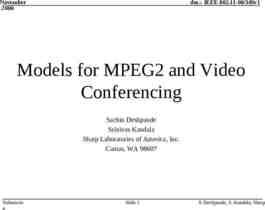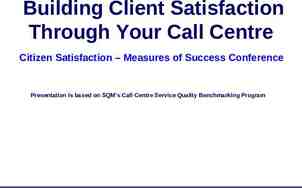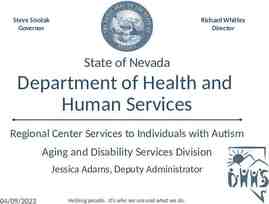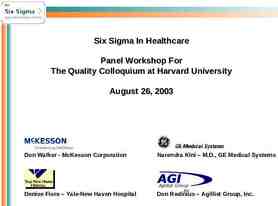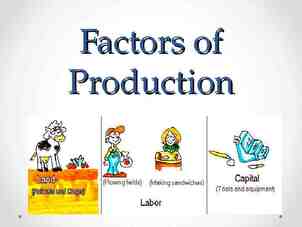Human Resource Management Training workshop BALADI CAP
81 Slides2.01 MB

Human Resource Management Training workshop BALADI CAP (Building Alliances for Local Advancement, Development, and Investment – CAP) Prepared by: Rania Skaine 1a

Agenda 09:30-11.00 Introduction to Human Resources Management & Manpower planning 11.00-11.15 Coffee Break 11:15-12:30 Recruitment and Performance Management 12:30-13:00 Performance Management exercise (part 1) 13.00-14.00 Lunch break 14.00-14.30 Performance Management exercise (part 2) 14.30-16.00 Learning and Development and staff motivation 2

Training Objectives By the end of the workshop, participants should be able to: Demonstrate knowledge of human resource (HR) concepts and principles for planning, staff recruitment, and management Strengthen HR management and support in your organizations Define key performance management strategies and know how to apply staff performance management systems in your organizations Promote a culture of learning and development Identify methods to improve staff motivation and engagement 3

A. Human Resources in Lebanese CSOs 4

Most CSOs in Lebanon are small in terms of Human Resources with 77% having less than 10 employees 5 Source: eeas – “Mapping Civil Society Organizations in Lebanon

HR development and retention in CSOs is critical for their performance and ability to develop 77.4% of CSO reported that they have less than 10 employees and that they suffer from high staff turnover, mainly due to the fluctuation in funding. Most CSOs, mainly the smaller ones, rely heavily on part time staff as a way to reduce their cost. In addition many qualified staff leave small CSOs to join international organizations partly because they receive more attractive remuneration packages. This is resulting in the loss of qualified staff among CSOs and their having to recruit new, less capable staff on project basis, they are thus unable to capitalize on experience and learning gained on the job and through training programs provided. 6

Few organizations make use of volunteers, with 72% having less than 50 volunteers involved 7 Source: eeas – “Mapping Civil Society Organizations in Lebanon

B. HRM and Organization’s Strategy 8

Human Resources Management “ the effective management of an organization’s human resources is a major source of competitive advantage and may even be the single most important determinant of an organization’s performance over the long term.” 9 Source: (Sims, Ronald. 2002. Organizational Success Through Effective Human Resources Management).

To sustainably increase value, HR management must considerably increase the proportion of value-added tasks Value added GOAL 20% Administrative activities 80% Value-added activities HR management expands its strategic influence and takes on more valueadded tasks for the organization Value-added activities 35% 65% Administrative activities Time ACTUAL TARGET 10

The value-adding activities that frame the HR strategy are derived from the future business needs and targets Deriving HR strategy from business needs Future business needs HR needs What business are we in? What sort of people do we need in the business? Where are we going? What sort of organization do we need to get there? What are our strengths, weaknesses, opportunities and threats? To what extent are those strengths and weaknesses related to our HR capabilities? What opportunities do we have to develop and motivate our staff? What are the threats in areas such as skill shortages and the retention of key staff? What are the main strategic issues facing the business? To what extent do these issues involve organizational and HR considerations? What are the critical success factors that determine how well we achieve our vision? How far will business success be helped or hindered by the quality, commitment and attitudes of our employees? 11

HR Strategy and Organizational Results Recruitment & Selection Organizational Strategy Training & Development Performanc e Managemen t Organizational Results Human Resource Strategy Reward Managemen t Career Development 12

D. Core competencies for HRM 13

HRM is the philosophy, strategic approach, principles, policies, procedures and practices related to the management of an organization’s employees Human Resource Management – Core Competencies 1 Develop realistic, effective human resource policies and procedures, and a good understanding of the laws governing labor and manpower 2 Assess staffing needs accurately and recruit the right and qualified staff members 3 Develop comprehensive, result oriented job descriptions 4 Establish and implement staff performance management 5 Establish and implement a staff professional development system 6 Retain and motivate employees 14

1. Policies and procedures 2. Manpower planning 3. Recruitment 4. Performance Management 5. Learning & Development 6. Retention & Motivation 15

The first element for successful HRM is defining a clear & realistic policy and accompanying procedures clearly written in a manual A policy is a statement of principles, values, intent or guiding actions that establishes clear commitment by the organization and sets a basis for decision making and resource allocation. Procedures are specific steps taken to implement the policy. Policies and procedures o document the overall systems of rules and regulations to deal with personnel issues within the organization o are unique to an organization o can be borrowed and adapted o must be clearly articulated to all current and incoming staff o are usually outlined in an employee manual. 16

Formulation of HR Policies ABC Organization has found it appropriate to formulate an HRM policy given that the organization is growing and there are more employees in the company. Policy example: “In order to get highly-skilled manpower for our company, all vacant and new positions will be advertised through recruitment agencies. In cases where the appraisal system does not give us a competent employee for promotion, jobs will be advertised to outsiders.” 17

Characteristics of Effective Policies and Procedures Clearly written in plain language Define the rights and responsibilities of all staff Relevant to the organization and staff Comply with national labor laws Organized together in a single document Consistently applied Well disseminated, signature statements 18

1. Policies and procedures 2. Manpower planning 3. Recruitment 4. Performance Management 5. Learning & Development 6. Retention & Motivation 19

Where to Start: What Before Who Whether planning or assessing staffing needs, always start from clear objectives or a defined scope of work. You need to know what is to be done in order to determine who will do it. – Objectives may include strategic planning objectives or program objectives. – Scope of work (SOW): Activities in a proposal, an operational plan, a work plan for a project or what a consultant is to do. 20

Staffing plans A staffing plan defines the human resources required to successfully achieve an organization’s implementation and contractual responsibilities. Outlines current staff positions and skills Illustrates gaps in staff coverage Outlines new services/programs requiring new or adjusted staff resources Offers timelines for adding or adjusting staff Has budget parameters for staff resources Is updated annually as part of planning 21

Assessing Staffing Needs When to assess staffing needs: During strategic and operational planning When a new program is planned or proposed When outcomes or achievements fall short of a program’s and/or organization’s expectations When staff complain they are overworked 22

There are basically three steps to estimating staffing needs: 1. Defining the specific activities that need to be carried out 2. Deciding who should carry out those activities 3. Estimating how much time will be needed to carry out the activities 23

Assessing staffing needs What to assess: Skills required to fulfill organization’s objective, project’s scope of work or job expectations Time required to complete the tasks (full-or part-time position?) Staff required for this position (new or can existing staff add tasks to their job descriptions? Internal or external resources (hire staff or outsource)? 24

Skills Required What skills does the person(s) need to meet the program’s or the organization’s objectives? Think about: – Managerial skills: Does the person need to oversee a program and project or project staff, a department or an activity? – Administrative or financial management skills: Does the person need to carry out or oversee administrative or financial management tasks such as transportation or operations, logistics or purchasing equipment? – Technical skills: Does the person need specific technical capabilities in HR, training, family planning, disaster relief, statistical analysis or specific computer or technology skills (MS Access, MS Excel, SSPS, website management/design, mobile phone surveys, etc.) Review your existing staff. Do you have these skills in your organization already? 25

Time required FTE: FTE stands for full-time equivalent. It means a staff member who works all the hours required in a full-time position. In Lebanon forty eight (48) hours is the maximum duration of work per week (except for agricultural corporations) Your organization should have policies that define full-time employment. How much time will a person need to work to fulfill the job requirements? 5 hours a week? 10 hours a week? 10 days a year? Think through the job tasks to determine how much time is needed. 26

Estimating Time Estimating time can be challenging. Try the following. Interview. Interview existing staff with the same or similar job descriptions to get a sense of how much time they spend per week on specific tasks. Time-task analysis. If staff are unsure of how much time they spend on a task, have them keep a record for a day or a week and use it to make an estimate. Ask around. Contact other organizations with similar positions and ask what it takes to do the job. Analyze time sheets. If the job is currently performed by a staff member and if the hours are reported on a timesheet, gather the information there. (If an administrator divides work among projects you can tell how much each project requires.) 27

Which staff Can existing staff take on new responsibilities or are new staff required? Ask the following questions: 1.Are all staff members who are qualified to carry out the new tasks currently fully engaged? 2.Are any activities due to end in the next few months? Will staff responsible for them soon have time available? 3.Are new programs that demand similar skills scheduled to start soon? Will qualified staff be engaged in those activities? 28

Internal or External Hire someone, use existing staff or contract out the work to another organization? Hiring has associated and long-term costs that your organization should be prepared to sustain. It is sometimes hard to find people for part-time positions. Some tasks require technical expertise only periodically or as needed (e.g., IT, contract review, payroll). These activities lend themselves well to outsourcing. 29

Manpower Planning Organizational Strategy Job Analysis What staff do we need to do the job? What is the impact on our wage and salary allocations? What staff is available in the organization? Company data Performance reviews Training & Development Is there a match? If not, what kind of staff do we need and how do we recruit them? 30

Manpower Planning Factors Staff Turnover Projections (Retirement, Resignations & Terminations) Factors determining Manpower Forecasts Estimate future needs for staff based on corporate plans and forecasts Financial capacity 31

1. Policies and procedures 2. Manpower planning 3. Recruitment 4. Performance Management 5. Learning & Development 6. Retention & Motivation 32

The goal of recruiting is to identify people who display a good fit with the position and organization Recruiting triangle Organization Culture Values POSITION Tasks Responsibilities Contact and select people by matching PERSON Knowledge Skills Experience 33

Factors Affecting Recruitment Macroeconomic conditions of the country When the economic conditions are relatively difficult, there will usually be an over supply (i.e. the number of applicants will be higher than the demand). In such a case, the organization will find it relatively easier to find and select the right candidates. Availability of manpower in selected sectors When the skill or competence required is ‘rare’ or ‘specialized,’ the company will have more difficulty in recruiting staff. Organization’s reputation If the organization has a good brand name or reputation, it will be relatively easier to recruit staff as the best talent will flock to apply for a position. 34

Several tools are available for selecting candidates – two types: classical-pragmatic and innovative-scientific tools Personnel selection tools Classical-pragmatic tools Read CV and cover letter Interviews Assessment of attitudes, skills and abilities Innovative-scientific tests Intelligence test Performance test Trial jobs Integrity test School grades Biographical questionnaire Graphology Personality test 35

Types of Selection Tests and guidelines Guidelines Cognitive Ability Tests Individualized assessment that measures general mental ability or intelligence Personality Tests Measures personality characteristics related to future job performance, e.g. Extroversion & introversion Emotional stability Agreeableness Conscientiousness Openness to experience Use tests in conjunction with other assessments methods like structured interviews for reliability Selection tests are used for occupations where large number of recruits are required Test should be administered only by people who have been trained on it Provide test takers with clear instructions on how to take the test 36

There are six central elements for selecting and acquiring staff and creating initial loyalty to the organization Factors for successful recruiting Easy-to-use scoring grid Clear profile of requirements/ clear criteria Good preparation for each candidate with help of CV and cover letter Several assessors involved SUCCESSFUL RECRUITING Objectivity Transparency/ feedback 37

To successfully recruit staff there are several steps to take to ensure a smooth process The steps required for the recruitment of staff include 1.Conduct a job analysis and define positions required 2.Develop a job description for each position required 3.Create and publish a job announcement or advertisement after defining the requirements 4.Form a small recruitment committee 5.Shortlist applicants 6.Conduct interviews and/or tests if necessary 7.Make a decision on selection and offer the position to selected candidates 8.Conduct reference check and get biodata information 9.Sign employment contract 10.Conduct orientation and training 38

To successfully recruit staff there are several steps to take to ensure a smooth process – Back-up (1/2) Conduct a job analysis and define positions required Develop a Work Breakdown structure (WBS). The WBS helps you in defining all the tasks required and how those tasks should be handled, leading to the development of positions required for your program. The size of the program and geographical spread would dictate how many people should assume the position Develop a job description for each position required Develop a comprehensive job description based on the position requirements and tasks to be performed Create and publish a job announcement or advertisement Announcing vacancies is not only important for spreading the word but is also good for the equal opportunity employment policy There are several ways to announce vacancies from the costly ones to those that are free. E.g. Newspaper or other media Internet websites specializing in job advertisements Networking Directly contact individuals you know as potential candidates 39 Encourage existing staff to apply

To successfully recruit staff there are several steps to take to ensure a smooth process – Back-up (2/2) Form a small recruitment committee Forming a small committee is a good way to avoid subjective recruitment results It is best to avoid recruitment process that is carried by one person throughout the process Shortlist applicants Divide candidate into 3 categories: 1) Strong candidates, 2) Potential candidates, 3) Not-qualified Shortlisting candidates helps avoid waste of time and resources on the process Form an interview panel that consists of 2-3 persons max to conduct the interview. More than 3 interviewers at once might be intimidating Alternatively you can conduct the interview in 2 stages , one to screen out the prospective candidates, and second with the senior management who will only meet shortlisted candidates Conduct interviews and/or tests if necessary 40

Key metrics of effective recruitment Retention rate Job satisfaction Cost per job filled Time per job filled Number of jobs filed Number of candidates applying to number of candidates shortlisted to number of candidates selected Satisfaction of hiring manager with person recruited Number of candidates applying 41

1. Policies and procedures 2. Manpower planning 3. Recruitment 4. Performance Management 5. Learning & Development 6. Retention & Motivation 42

What is Performance Management? A systematic process for improving organizational performance by developing the performance of individuals and teams. A process for establishing a shared understanding about what is to be achieved and how it will be achieved. A continuous process not a one-time event. Involves working together in partnership to achieve desired results. Involves defining expectations and measuring output. Focuses on future performance planning and improvement. Provides the basis for regular and frequent dialogue. It is regarded as transformational. 43

Why is Performance Management Important – For the Individual? What am I supposed to do? (Targets) Why do I need to do this? (The big picture) What resources do I need? (Skills, equipment, etc.) How am I going to do it? (Process) How do I know my level of achievement? (Evaluation) What is in it for me? (Rewards) 44

Why is Performance Management Important – For the Organization? Communicates the shared vision or mission and values to all its employees Helps to set individual/team targets that are related both to business needs and organizational objectives Helps conduct regular, formal reviews of progress towards these targets Identifies training, development, and reward outcomes Evaluates overall performance to allow changes and improvements to be made 45

Integrated Performance Management Process Planning Performance Rewarding Performance Managing Performance Reviewing Performance 46

PM Principles – Planning and Managing Planning Managing It seeks to develop a management style that is open and honest and encourages two-way communication between superiors and subordinates. It seeks to develop an approach to managing people by coaching, counseling, and motivating them. It relies on consensus and cooperation rather than control and coercion. It encourages self-management of individual performance. It requires giving and receiving continuous feedback through regular formal and informal meetings. Involves articulating the organization’s business plans and priorities. Translates organizational goals into department goals and individual targets/tasks. Clearly defines expected levels of performance (performance measures for targets/performance standards for tasks). Creates a shared understanding of what is to be achieved and how it is to be achieved. 47

PM Principles – Reviewing and rewarding Reviewing Rewarding It measures and assesses all performance against jointly agreed targets/tasks and predetermined behaviors. It applies to all employees of the organization. Performance reviews should be open, transparent, and honest with a view to reinforcing good performance and confronting poor performance through dialogue based on mutual respect. Performance reviews should plan for performance improvements and skills acquisition. It helps in identifying development needs that will be addressed through training (on the job, internal, external) and support (managerial and organizational). The system will provide for recognition and special awards for outstanding performance. Promotions may be de-linked from rewards and purely based on the individual moving into a position of higher responsibility. Promotions will be based on the individual demonstrating through knowledge, skills, and attitudes and the ability to handle the higher responsibility when such vacancies occur. 48

Criteria for Reviewing Performance Achievements in relation to mutually-agreed objectives The level of knowledge and skills possessed and applied Behavior on the job as it affects performance (competencies) The degree to which the behavior upholds the core values of the organization Day-to-day effectiveness 49

Behavioral Examples TASK – Staff assigned to travel upcountry for review with partner organization. SITUATION – The day before the meeting there is acute fuel shortage in Beirut. ACTION – – 1. He decides that he cannot travel in his car and does not make the trip. 2. He uses public transport to make the trip. RESULT – 1. He does not meet with the PO, and the boss is angry because the meeting was critical and information was required for a report submission to donor. – 2. He completes his assignment and the organization is able to produce relevant data and information for the report. The organization receives additional funding for activities. 50

Eight Steps for Conducting a Performance Appraisal (1/2) 1 Control the environment. Schedule a time. Reduce interruptions. Warm-up. 2 State the purpose of the discussion. Go over advantages of the appraisal process. Tell what information will be used for the evaluation. 3 Ask for the employee’s opinion. Ask how the employee thinks he or she did. Use open-ended questions. Use your best listening skills. 4 Present your assessment. Be candid and specific. Give corrective feedback. Give positive feedback. 51

Eight Steps for Conducting a Performance Appraisal (2/2) 5 Build on the employee’s strengths. Ask the employee to name his or her strengths. Share your opinion of those strengths. Focus on performance, not personality. 6 Ask for the employee’s reaction to your assessment. Listen to what the employee has to say. Reach an agreement on the evaluation rating. 7 Set specific goals. List opportunity areas for improvement. Identify current training needs. Set realistic but stretching goals. 8 Close the discussion. Summarize the meeting. Sign the appraisal form. Thank the employee and explain the next step. 52

Do’s and Don’ts Do’s Be open-minded Reinforce good performance Manage poor performance Listen actively and with empathy Maintain reviewee’s self esteem Focus on the future Don’ts Don’t be judgmental Don’t be negative, harsh, and critical Don’t dominate the meeting 53

INSTRUCTIONS: Label each comment as either an evaluation of performance (PF) or personality (PS). 1. Your work is always accurate and on time. 2. You don’t care about your customer’s needs. 3. When you show up for work late, the other employees have to cover for you. 4. You are dependable, courteous, and a team player. 5. You’re not a “people person.” 6. You speak unenthusiastically. Sometimes, customers have difficulty understanding you. 7. You have a lot in common with management. 8. You have a sweet disposition. Everyone here really likes you. 54

Managing Poor Performance Identify and agree on the problem Establish the reason(s) for the shortfall Decide and agree on the action required Provide support, coaching, and resources 55

Giving & receiving feedback Give feedback Receive feedback Build feedback into the job Provide feedback on actual events Provide positive and negative feedback Describe, don’t judge Refer to specific behaviors Ask questions rather than make statements Select key issues and restrict yourself to them Focus on aspects within the individual’s control Have an open mind Receive feedback objectively Take positive and negative feedback in the right spirit Be committed to improvement Don’t feel threatened 56

Points to Consider When Giving a Rating Rating reflects performance during current year only It’s a managerial decision not a mathematical calculation. Consistency of performance Criticality of timing Awareness of – Halo effect: Positive bias – Devil’s Horn effect: Negative bias – Recency effect: Remembering the last behavior 57

1. Policies and procedures 2. Manpower planning 3. Recruitment 4. Performance Management 5. Learning & Development 6. Retention & Motivation 58

Strategic HR Development Strategic Human Resource development involves – introducing, eliminating, modifying, directing, and guiding processes in such a way that all individuals and teams are equipped with – the skills, knowledge, and competencies they require to undertake current and future tasks required by the organization. - Walton, 1999 59

Learning & Development Philosophy Learning & Development (L&D) activities make a major contribution to the attainment of the organization’s objectives L&D plans and programs should be integrated with and support the achievement of HR and business strategies L&D should be performance related and should be linked to bottom-line results Everyone should be encouraged and given the opportunity to learn Personal development processes provide the framework for individual and self-directed learning Responsibility for development rests with individual employees 60

Developing a Learning Culture Develop and share the vision Empower employees – provide freedom to manage their work within certain boundaries Adopt a facilitative style of management where responsibility for decision-making is ceded to the employee Provide a learning environment where learning capabilities can be discovered and applied Use coaching techniques to draw out talents Guide employees through work challenges and provide time, resources, and critical feedback 61

Approaches to Learning & Development Informal learning – experiential – Job rotation – E-learning – Cross functional or project work – Coaching & mentoring Formal learning – planned & systematic – Training programs – Outdoor learning – Coaching Self-directed learning 62

The Learning Gap What is Actual performance levels Knowledge and skills possessed Learning gap What should be Performance levels required Knowledge and skills required 63 Armstrong, 2009

Learning needs analysis Organization Analysis of business plans Department Analysis of human resource plans Performance & development reviews Individual Role Analysis 64 Armstrong, 2009

Competency Profile Position Required Competency Training & Development Manager Communication skills 1 2 3 4 5 Public speaking Leadership skills Curriculum development Training Evaluation Supervisor Communication skills Leadership skills Analytical ability Planning & Organizing Equipment maintenance Achievement orientation 65

Training programs Off the job Formal course Simulation Retreats On the job Job instruction training Apprenticeship Job rotation Mentoring 66

Evaluation of Training Reaction Evaluate trainees’ reaction to the program Learning Test the trainees to determine if they learned the principles and skills Behavior Application Has the behavior of the trainee changed because of the training program? Business Impact What final results were achieved in terms of the training objectives? 67

Barriers to Transfer of Learning after Training Lack of reinforcement on the job Interference from the work environment Non-supportive organizational culture Trainees’ perception of program being impractical Separation from inspiration or support of the trainer 68

1. Policies and procedures 2. Manpower planning 3. Recruitment 4. Performance Management 5. Learning & Development 6. Retention & Motivation 69

Motivation and retention are gaining more and more importance as their financial aspects become evident Definition Key Elements Staff retention refers to the policies, benefits, recognition and reward systems an organization uses to make staff feel valued and committed Effective leadership Missions that drive Competitive salaries Staff recognition Performance based awards or bonuses Positive relationships with colleagues (a good team environment) 70

Types of Motivation INTRINSIC MOTIVATION EXTRINSIC MOTIVATION Self-generated factors (need to be competent, self-determining) Example: Work itself (when the work is important, challenging, with autonomy) Enhanced by job or role design When things are done to or for people to motivate them Examples: incentives, pay raise, praise, promotion, punishment, disciplinary action, criticism 71

Brainstorming What does your organization do to retain staff? Does it work? What is the average number of years employees work at your organization? Do you ever assess employee engagement? How and how often does your organization do this? 72

What influences staff retention? Salary. Are you competitive? How do the salary and benefits of your organization compare with similar organizations? Benefits and incentives Flexible hours, good health insurance, educational allowances, professional development opportunities, performance bonuses, commissions for obtaining funding, etc. Working conditions Access to necessary equipment, pleasant working space, time and environment to do work, good relationships with colleagues, motivated colleagues, positive culture in the organization 73

What influences staff retention? Opportunities for growth Internal recruitment, professional development opportunities, encouragement from management to expand skills Job security A contract and a stable organization with sufficient funds to function for the near future Recognition Overt and/or public recognition of a job well done, objectives achieved or a successful program A sense one is contributing to a real purpose –mission Recognized links between individual performance and the overall performance of the organization –achieving an organization’s objectives or mission 74

Motivation Theories Instrumentality theory (Taylor, 1911) the belief that if we do one thing it will lead to another assumes that people will be motivated to work if rewards and penalties are tied directly to performance rationale for incentive pay Reinforcement theory (Hull, 1951) As people gain experience in satisfying needs, they perceive that certain actions help achieve goals while others are unsuccessful. The successful actions are repeated when a similar need arises. Conversely, failures or punishments provide negative reinforcements Conditioning occurs or responses become established Content or Needs theory (Maslow, 1954) Focuses on the content of motivation in the shape of needs Belief that an unsatisfied need creates tension and disequilibrium Identifies a goal that will satisfy the need All behavior is motivated by unsatisfied needs 75

MASLOW’S HIERARCHY OF NEEDS Self-actualization personal growth and fulfilment Esteem needs achievement, status, responsibility, reputation Belongingness and Love needs family, affection, relationships, work group, etc. Safety needs protection, security, order, law, limits, stability, etc. Biological and Physiological needs basic life needs - air, food, drink, shelter, warmth, sex, sleep, etc. 76

Herzberg’s Two-factor Theory Job Dissatisfaction Influenced by Hygiene Factors Working conditions Workplace relationships Policies & rules Quality of supervision Basic wage, salary Herzberg’s Two-Factor Principles Improving the motivator factors increases motivation Improving the hygiene factors decreases job dissatisfaction Job Satisfaction Influenced by Motivator Factors Achievement Recognition Responsibility Work itself Advancement Personal development 77

Herzberg’s Two-Factor Theory Employees’ wants are divided into two groups; 1. The need to develop in one’s occupation as a source of personal growth 2. Fair treatment in compensation, supervision, working conditions, and administrative practices The fulfilment of the first group leads to increased motivation The fulfilment of the needs of the latter group does not motivate the individual to extra performance; it only prevents dissatisfaction and poor job performance 78

Employee Engagement & Commitment Employee engagement happens when people at work are interested in and positive, even excited about their jobs and are prepared to go the extra mile to get them done to the best of their ability. Commitment refers to attachment and loyalty to the organization. Engagement Commitment job-oriented organization-oriented 79

Employee Engagement and commitment Engagement strategies Intrinsic motivation through the Developing commitment work itself The work environment The role and leadership qualities of line managers Opportunities for personal growth and contribution – a learning culture Developing ownership – Participating in decisions on new developments and changes in work practices Communication strategies – Use of different and complementary channels of communication – videos, newsletter, briefings, notice boards. Leadership development – Programs to improve quality of leadership Developing HR practices that enhance commitment 80
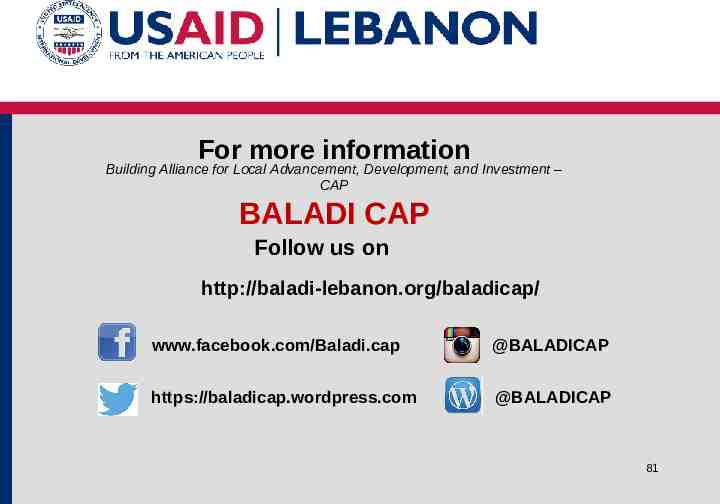
For more information Building Alliance for Local Advancement, Development, and Investment – CAP BALADI CAP Follow us on http://baladi-lebanon.org/baladicap/ www.facebook.com/Baladi.cap @BALADICAP https://baladicap.wordpress.com @BALADICAP 81

